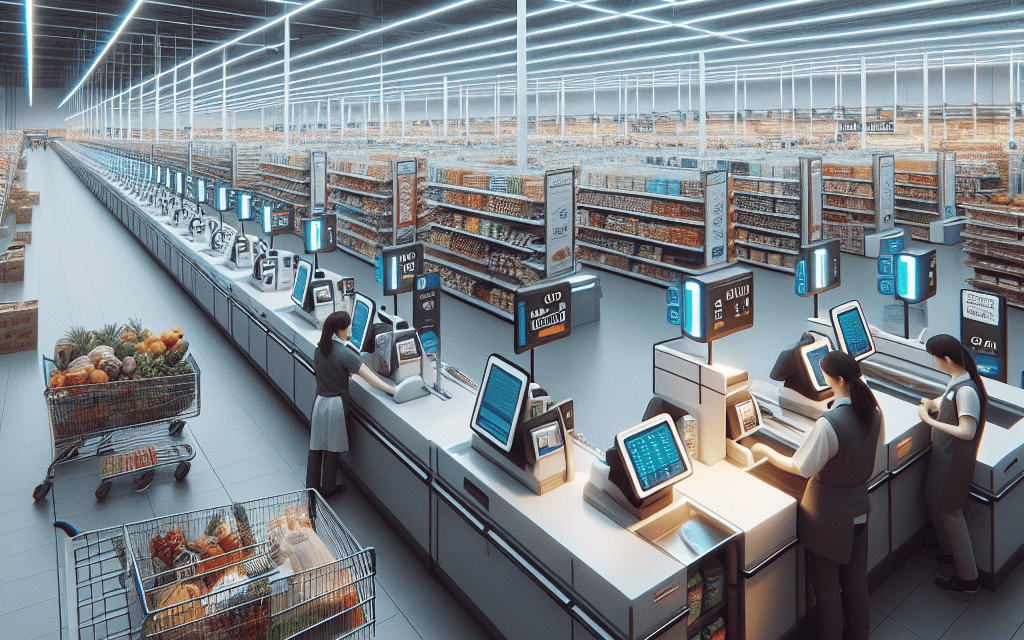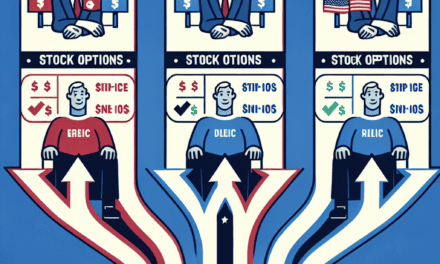-
Table of Contents
- Introduction
- Impact Of Removing Self-Checkout On Customer Experience
- Reasons Behind Walmart’s Decision To Remove Self-Checkout
- How Walmart’s Checkout Changes Affect Store Operations
- Customer Reactions To The Removal Of Self-Checkout
- Comparing Traditional Checkout Vs. Self-Checkout At Walmart
- The Future Of Retail Checkout: Lessons From Walmart
- Walmart’s Strategy Shift: What It Means For The Retail Industry
- Analyzing The Financial Implications Of Removing Self-Checkout
- Employee Perspectives On The Return To Traditional Checkout
- How Walmart’s Checkout Changes Influence Competitors
- Q&A
- Conclusion
“Bringing Back the Human Touch: Walmart Reintroduces Cashier Service in Select Stores”
Introduction
In recent developments, Walmart, the retail giant known for its widespread adoption of self-checkout technology, has decided to remove self-checkout lanes from select stores. This strategic move marks a significant shift in the company’s approach to enhancing customer experience and operational efficiency. The decision comes amid growing concerns over issues such as theft, customer dissatisfaction, and the need for more personalized service. By reintroducing traditional cashier-staffed lanes in these locations, Walmart aims to address these challenges and improve the overall shopping experience for its customers. This change reflects Walmart’s ongoing efforts to balance technological innovation with customer service excellence in an ever-evolving retail landscape.
Impact Of Removing Self-Checkout On Customer Experience
Walmart’s decision to remove self-checkout lanes from select stores marks a significant shift in its approach to customer service and retail operations. This move, which has sparked considerable discussion among consumers and industry experts alike, is aimed at enhancing the overall shopping experience. By reintroducing traditional cashier-staffed lanes, Walmart seeks to address several issues that have arisen with the widespread implementation of self-checkout systems.
One of the primary motivations behind this decision is the improvement of customer service. Self-checkout lanes, while convenient for some, have often been criticized for their impersonal nature and the technical difficulties they can present. Customers frequently encounter problems such as scanning errors, unresponsive machines, and the need for assistance with age-restricted items. These issues can lead to frustration and longer wait times, detracting from the efficiency that self-checkout is supposed to offer. By reinstating cashier-staffed lanes, Walmart aims to provide a more personalized and seamless shopping experience, where customers can interact with knowledgeable staff who can assist with any issues that may arise.
Moreover, the removal of self-checkout lanes is expected to have a positive impact on employment within the stores. The shift back to traditional checkout methods necessitates the hiring of additional staff, which could lead to job creation in the communities where these stores are located. This move aligns with Walmart’s broader commitment to supporting local economies and providing employment opportunities. By increasing the number of staff on the floor, Walmart not only enhances customer service but also contributes to the economic well-being of the areas it serves.
In addition to improving customer service and boosting employment, the removal of self-checkout lanes addresses concerns related to theft and loss prevention. Self-checkout systems have been associated with higher rates of shoplifting, as the lack of direct supervision can make it easier for individuals to bypass payment for certain items. By reinstating cashier-staffed lanes, Walmart can reduce the risk of theft and ensure that transactions are conducted more securely. This change is likely to result in a decrease in inventory shrinkage, ultimately benefiting the company’s bottom line.
Furthermore, the decision to remove self-checkout lanes reflects Walmart’s responsiveness to customer feedback. Many shoppers have expressed a preference for traditional checkout methods, citing the convenience of having a dedicated cashier to handle their transactions. By listening to its customers and adapting its operations accordingly, Walmart demonstrates its commitment to meeting consumer needs and enhancing the shopping experience.
While the removal of self-checkout lanes may initially seem like a step backward in terms of technological advancement, it is, in fact, a strategic move to prioritize customer satisfaction and operational efficiency. By focusing on the human element of retail, Walmart is positioning itself to better serve its customers and create a more enjoyable shopping environment. As the retail landscape continues to evolve, it will be interesting to observe how other companies respond to Walmart’s decision and whether similar changes will be implemented across the industry.
In conclusion, Walmart’s removal of self-checkout lanes from select stores is a multifaceted decision that aims to improve customer service, increase employment, reduce theft, and respond to consumer preferences. By prioritizing these aspects, Walmart is taking a proactive approach to enhancing the overall shopping experience, ultimately benefiting both the company and its customers.
Reasons Behind Walmart’s Decision To Remove Self-Checkout
Walmart’s recent decision to remove self-checkout lanes from select stores has sparked considerable discussion among consumers and industry analysts alike. This move, which may seem counterintuitive in an era increasingly dominated by automation and technology, is driven by a confluence of factors that underscore the complexities of retail operations. Understanding these reasons requires a closer examination of the challenges and opportunities presented by self-checkout systems.
To begin with, one of the primary reasons behind Walmart’s decision is the issue of theft and loss prevention. Self-checkout systems, while convenient, have been associated with higher rates of shoplifting and accidental non-scanning of items. The absence of a cashier overseeing each transaction creates opportunities for both intentional and unintentional loss. Despite advancements in technology, such as weight sensors and cameras, these systems have not entirely mitigated the risk of theft. Consequently, Walmart has found that the cost savings from reduced labor do not always offset the losses incurred from increased theft, prompting a reevaluation of their deployment in certain locations.
Moreover, customer experience plays a significant role in this decision. While self-checkout lanes offer speed and convenience for tech-savvy shoppers, they can also lead to frustration for those who are less comfortable with technology or who encounter technical glitches. Long lines at self-checkout stations, often due to customers needing assistance, can negate the time-saving benefits these systems are supposed to provide. By reintroducing traditional cashier-staffed lanes, Walmart aims to enhance the shopping experience for a broader range of customers, ensuring that all patrons feel accommodated and valued.
In addition to these considerations, labor dynamics are also at play. The retail giant’s decision aligns with a broader trend of investing in human capital and improving employee-customer interactions. By reducing reliance on self-checkout systems, Walmart can reallocate resources to hire and train more staff, thereby enhancing customer service and potentially increasing job satisfaction among employees. This shift not only addresses concerns about job displacement due to automation but also reinforces Walmart’s commitment to community engagement and support.
Furthermore, the decision to remove self-checkout lanes is informed by regional and demographic factors. Walmart recognizes that the effectiveness of self-checkout systems can vary significantly depending on the location and customer base. In areas where customers prefer personal interaction or where there is a higher incidence of theft, traditional checkout lanes may be more appropriate. This tailored approach allows Walmart to optimize its operations and better serve the unique needs of each community.
Finally, it is important to consider the broader strategic implications of this decision. By selectively removing self-checkout lanes, Walmart is not abandoning technology but rather recalibrating its approach to ensure that technological advancements align with its overarching business objectives. This nuanced strategy reflects a commitment to balancing innovation with practicality, ensuring that the adoption of new technologies enhances rather than detracts from the overall customer experience.
In conclusion, Walmart’s decision to remove self-checkout lanes from select stores is a multifaceted response to challenges related to theft, customer experience, labor dynamics, and regional preferences. By addressing these issues, Walmart aims to create a more secure, efficient, and customer-friendly shopping environment. As the retail landscape continues to evolve, this decision underscores the importance of adaptability and the need for retailers to continually reassess the impact of technology on their operations.
How Walmart’s Checkout Changes Affect Store Operations
Walmart’s recent decision to remove self-checkout lanes from select stores marks a significant shift in its approach to retail operations, reflecting broader trends and challenges in the retail industry. This move, while surprising to some, is rooted in a complex interplay of factors that influence store operations, customer experience, and overall business strategy. Understanding these dynamics is crucial for comprehending the implications of this change.
To begin with, the introduction of self-checkout lanes was initially seen as a way to enhance efficiency and reduce labor costs. By allowing customers to scan and pay for their items independently, Walmart aimed to streamline the checkout process, reduce wait times, and allocate staff to other critical areas within the store. However, the reality of self-checkout has proven to be more nuanced. While some customers appreciate the convenience and speed, others find the technology intimidating or frustrating, leading to a mixed reception.
Moreover, the issue of theft and loss prevention has become increasingly significant. Self-checkout systems, while innovative, have been associated with higher rates of shoplifting and accidental non-scans. This has prompted Walmart to reconsider the balance between technological advancement and security. By removing self-checkout lanes in certain locations, the company aims to mitigate these risks and enhance the overall integrity of its operations.
In addition to security concerns, customer service remains a pivotal aspect of Walmart’s strategy. The presence of human cashiers can significantly enhance the shopping experience, offering personalized assistance and resolving issues that may arise during the checkout process. This human interaction is particularly valued by certain demographics, including older customers and those less familiar with digital technologies. By reinstating traditional checkout lanes, Walmart seeks to cater to these preferences, thereby improving customer satisfaction and loyalty.
Furthermore, the decision to remove self-checkout lanes is not uniform across all Walmart stores. Instead, it reflects a tailored approach that considers the unique characteristics and needs of each location. Factors such as store size, customer demographics, and regional shopping habits play a crucial role in determining the most effective checkout strategy. This localized approach allows Walmart to optimize its operations and better serve its diverse customer base.
Transitioning from self-checkout to traditional lanes also has implications for staffing and employment. While self-checkout was initially seen as a means to reduce labor costs, the reintroduction of human cashiers may lead to increased employment opportunities within the affected stores. This shift underscores Walmart’s commitment to investing in its workforce and providing quality service to its customers.
In conclusion, Walmart’s decision to remove self-checkout lanes from select stores is a strategic move that reflects a careful consideration of various operational factors. By addressing security concerns, enhancing customer service, and adopting a localized approach, Walmart aims to optimize its store operations and improve the overall shopping experience. As the retail landscape continues to evolve, Walmart’s ability to adapt and respond to changing customer needs will be crucial in maintaining its position as a leader in the industry. This decision serves as a reminder of the importance of balancing technological innovation with human interaction in the pursuit of operational excellence.
Customer Reactions To The Removal Of Self-Checkout
In recent developments, Walmart has made the decision to remove self-checkout lanes from select stores, a move that has sparked a variety of reactions from customers. This decision comes amidst ongoing debates about the efficiency and customer satisfaction associated with self-service technology in retail environments. As Walmart continues to evaluate the impact of self-checkout on its operations and customer experience, the removal of these lanes has prompted both praise and criticism from its diverse customer base.
To begin with, some customers have expressed relief at the removal of self-checkout options. For these individuals, the traditional cashier-assisted checkout process is preferred due to its perceived reliability and personal interaction. Many customers appreciate the human element that comes with having a cashier scan and bag their items, as it often leads to a smoother and more efficient shopping experience. Additionally, some shoppers have reported feeling frustrated with the technology used in self-checkout lanes, citing issues such as unresponsive touchscreens, unexpected errors, and difficulties with scanning certain items. For these customers, the return to cashier-assisted lanes is seen as a positive change that enhances their overall shopping experience.
Conversely, there are customers who have expressed disappointment over the removal of self-checkout lanes. For many, self-checkout represents a convenient and time-saving option, particularly for those who prefer to shop quickly and independently. The ability to scan and bag items at one’s own pace is a significant advantage for these shoppers, who often have busy schedules and appreciate the autonomy that self-checkout provides. Furthermore, some customers have noted that self-checkout lanes tend to have shorter lines, allowing for a faster exit from the store. The removal of this option has led to concerns about longer wait times and increased congestion at traditional checkout lanes, which could potentially diminish the efficiency of the shopping experience.
In addition to these differing perspectives, there are also customers who remain indifferent to the change. For these individuals, the choice between self-checkout and cashier-assisted lanes is largely inconsequential, as they prioritize other aspects of their shopping experience, such as product selection and store layout. This group of customers is likely to adapt to the changes without significant impact on their overall satisfaction with Walmart.
As Walmart continues to assess the implications of removing self-checkout lanes, it is important to consider the broader context of customer preferences and technological advancements in the retail industry. The decision to eliminate self-checkout in certain locations may be influenced by factors such as store size, customer demographics, and regional shopping habits. Moreover, Walmart’s ongoing commitment to enhancing customer experience may lead to further innovations and adjustments in its checkout processes.
In conclusion, the removal of self-checkout lanes from select Walmart stores has elicited a range of reactions from customers, highlighting the diverse preferences and priorities of the retail giant’s clientele. While some customers welcome the return to traditional cashier-assisted lanes, others lament the loss of convenience and autonomy that self-checkout provides. As Walmart navigates these changes, it remains to be seen how the company will balance technological advancements with customer satisfaction in its pursuit of an optimal shopping experience.
Comparing Traditional Checkout Vs. Self-Checkout At Walmart

In recent years, the retail landscape has undergone significant transformations, with technological advancements playing a pivotal role in reshaping consumer experiences. Among these innovations, self-checkout systems have emerged as a prominent feature in many retail environments, including Walmart. However, the retail giant has recently made headlines by deciding to remove self-checkout options from select stores, prompting a renewed discussion on the merits and drawbacks of traditional checkout versus self-checkout systems.
To begin with, self-checkout systems were introduced with the promise of enhancing efficiency and convenience for both retailers and customers. By allowing customers to scan and pay for their items independently, these systems aimed to reduce wait times and streamline the shopping process. For Walmart, a company that serves millions of customers daily, the potential benefits of self-checkout were clear. The technology promised to alleviate congestion during peak shopping hours and reduce labor costs by minimizing the need for cashiers. Moreover, self-checkout appealed to tech-savvy consumers who appreciated the autonomy and speed it offered.
However, despite these advantages, self-checkout systems have not been without their challenges. One of the primary concerns has been the increased risk of theft and fraud. Without the constant supervision of a cashier, some customers may be tempted to exploit the system, leading to significant losses for retailers. Additionally, technical glitches and malfunctions can disrupt the checkout process, causing frustration for customers and necessitating the intervention of store staff. These issues can negate the time-saving benefits that self-checkout systems are supposed to provide.
In contrast, traditional checkout lanes, staffed by human cashiers, offer a different set of advantages. Human interaction can enhance the shopping experience, providing a personal touch that technology cannot replicate. Cashiers can assist with price checks, handle complex transactions, and offer customer service that a machine cannot. Furthermore, traditional checkout lanes can be more accessible for individuals who may not be comfortable with technology, such as elderly customers or those with disabilities. This inclusivity is an important consideration for a retailer like Walmart, which serves a diverse customer base.
The decision by Walmart to remove self-checkout from select stores suggests a reevaluation of these factors. It indicates a recognition that while technology can offer efficiencies, it is not a one-size-fits-all solution. The move may also reflect feedback from customers who prefer the human interaction and reliability of traditional checkout lanes. By reintroducing staffed checkouts, Walmart may be aiming to enhance customer satisfaction and reduce the potential for loss through theft or error.
In conclusion, the comparison between traditional checkout and self-checkout at Walmart highlights the complexities of integrating technology into retail environments. While self-checkout systems offer speed and autonomy, they also present challenges that cannot be overlooked. Traditional checkouts, with their emphasis on human interaction and reliability, continue to hold significant value. As Walmart navigates these considerations, its decision to remove self-checkout from certain locations underscores the importance of balancing technological innovation with customer needs and operational realities. This ongoing evaluation will likely shape the future of retail, as companies strive to find the optimal blend of technology and human touch in their service offerings.
The Future Of Retail Checkout: Lessons From Walmart
In recent years, the retail industry has witnessed a significant shift towards automation, with self-checkout systems becoming a staple in many stores. These systems promise efficiency, reduced labor costs, and a streamlined shopping experience. However, Walmart, one of the largest retail giants, has recently made headlines by removing self-checkout options from select stores. This decision has sparked discussions about the future of retail checkout and the lessons that can be drawn from Walmart’s strategic move.
To understand the implications of Walmart’s decision, it is essential to consider the factors that led to the initial adoption of self-checkout systems. Retailers have long sought ways to enhance customer experience while optimizing operational efficiency. Self-checkout systems emerged as a solution, allowing customers to scan and pay for their items independently, thereby reducing wait times and freeing up staff for other tasks. However, the implementation of these systems has not been without challenges. Issues such as technical malfunctions, increased theft, and customer frustration have been reported, prompting retailers to reassess their strategies.
Walmart’s decision to remove self-checkout from certain locations can be seen as a response to these challenges. By reintroducing traditional checkout lanes, Walmart aims to address customer dissatisfaction and improve the overall shopping experience. This move highlights the importance of adaptability in the retail sector, as companies must continuously evaluate the effectiveness of their technologies and be willing to make changes when necessary. Moreover, it underscores the need for a balanced approach that considers both technological advancements and human interaction.
The removal of self-checkout systems also raises questions about the role of human employees in the retail environment. While automation has the potential to reduce labor costs, it can also lead to a depersonalized shopping experience. By reinstating staffed checkout lanes, Walmart is emphasizing the value of human interaction in fostering customer satisfaction. This decision aligns with the growing recognition that, despite technological advancements, human touch remains a crucial element in retail. Employees can provide personalized assistance, address customer concerns, and create a welcoming atmosphere that machines cannot replicate.
Furthermore, Walmart’s move offers valuable insights into the importance of customer feedback in shaping retail strategies. The decision to remove self-checkout was likely influenced by customer input, highlighting the significance of listening to consumer preferences and adapting accordingly. Retailers must remain attuned to the evolving needs and expectations of their customers to maintain a competitive edge. By prioritizing customer satisfaction, companies can build loyalty and enhance their brand reputation.
In addition to customer feedback, data analytics plays a pivotal role in informing retail decisions. Walmart’s vast network of stores generates a wealth of data that can be leveraged to identify trends and patterns. By analyzing this data, retailers can gain insights into customer behavior, preferences, and pain points. This information can guide strategic decisions, such as the removal of self-checkout systems, to optimize the shopping experience and drive business success.
In conclusion, Walmart’s decision to remove self-checkout from select stores serves as a valuable case study for the retail industry. It highlights the need for adaptability, the importance of human interaction, and the role of customer feedback in shaping retail strategies. As the industry continues to evolve, retailers must strike a balance between technological advancements and personalized service to meet the diverse needs of their customers. By doing so, they can ensure a seamless and satisfying shopping experience that fosters customer loyalty and drives long-term success.
Walmart’s Strategy Shift: What It Means For The Retail Industry
In a surprising move that has caught the attention of both consumers and industry analysts, Walmart has decided to remove self-checkout lanes from select stores across the United States. This decision marks a significant shift in the retail giant’s strategy, as self-checkout technology has been a staple in modernizing the shopping experience and reducing operational costs. The implications of this change are multifaceted, affecting not only Walmart’s operations but also the broader retail industry.
To understand the rationale behind Walmart’s decision, it is essential to consider the challenges and criticisms that self-checkout systems have faced. While these systems offer convenience and efficiency, they have also been associated with increased theft and operational issues. Customers often encounter technical glitches, leading to frustration and longer wait times. Moreover, the lack of human interaction in self-checkout lanes can detract from the overall shopping experience, particularly for those who value personalized service. By removing self-checkout lanes, Walmart aims to address these concerns and enhance customer satisfaction.
Furthermore, this strategic shift aligns with Walmart’s broader commitment to improving customer service. By reallocating resources from self-checkout systems to traditional cashier-staffed lanes, Walmart can provide more personalized assistance to shoppers. This move is expected to create a more engaging and supportive environment, fostering stronger customer loyalty. Additionally, the reintroduction of more cashier-staffed lanes may lead to increased employment opportunities, as more staff will be needed to manage these lanes. This could be a positive development for local communities, contributing to job creation and economic growth.
The decision to remove self-checkout lanes also reflects a growing trend in the retail industry towards re-evaluating the role of technology in customer interactions. While technology has undoubtedly transformed the retail landscape, there is a growing recognition that it should complement, rather than replace, human interaction. Retailers are increasingly focusing on creating a balanced approach that leverages technology to enhance, rather than detract from, the customer experience. Walmart’s move could signal a broader industry shift towards prioritizing human interaction in retail settings.
Moreover, this change may prompt other retailers to reassess their own strategies regarding self-checkout systems. As one of the largest and most influential retailers globally, Walmart’s decisions often set precedents for the industry. Competitors may closely monitor the outcomes of this strategy shift, evaluating whether similar changes could benefit their operations. This could lead to a reevaluation of the role of self-checkout technology across the retail sector, potentially influencing future innovations and developments.
In conclusion, Walmart’s decision to remove self-checkout lanes from select stores represents a significant strategic shift with wide-ranging implications for the retail industry. By prioritizing customer service and human interaction, Walmart aims to enhance the shopping experience and foster customer loyalty. This move also highlights a broader industry trend towards balancing technology with personalized service. As the retail landscape continues to evolve, Walmart’s strategy may serve as a catalyst for change, prompting other retailers to reconsider the role of technology in their operations. Ultimately, this decision underscores the importance of adapting to consumer preferences and maintaining a customer-centric approach in an increasingly competitive market.
Analyzing The Financial Implications Of Removing Self-Checkout
Walmart’s decision to remove self-checkout lanes from select stores marks a significant shift in its retail strategy, prompting a closer examination of the financial implications of such a move. As one of the largest retail chains globally, Walmart’s operational decisions often set trends within the industry, influencing competitors and suppliers alike. The removal of self-checkout options, which have been a staple in modern retail environments, raises questions about cost efficiency, customer experience, and the broader economic impact on the company.
To begin with, self-checkout systems were initially introduced as a cost-saving measure, reducing the need for human cashiers and thereby lowering labor costs. These systems allowed customers to scan, bag, and pay for their purchases independently, theoretically speeding up the checkout process and reducing wait times. However, the financial benefits of self-checkout have been a subject of debate. While the initial investment in technology and maintenance can be substantial, the anticipated savings in labor costs may not always materialize as expected. Moreover, self-checkout systems can be prone to technical issues, leading to increased maintenance expenses and potential disruptions in service.
Furthermore, the removal of self-checkout lanes could have implications for customer satisfaction and shopping behavior. While some customers appreciate the convenience and speed of self-checkout, others find the process cumbersome and prefer human interaction. By eliminating self-checkout options, Walmart may be aiming to enhance the in-store experience for those who value personalized service. This shift could potentially attract a demographic that prefers traditional checkout methods, thereby increasing customer loyalty and, ultimately, sales. However, it is crucial to consider that this change might alienate tech-savvy customers who favor the autonomy and efficiency of self-checkout, potentially driving them to competitors who continue to offer such services.
In addition to customer experience, the decision to remove self-checkout lanes may also impact employee dynamics within Walmart stores. Reintroducing more cashier positions could lead to increased employment opportunities, which may be viewed positively in communities where job creation is a priority. This move could also improve employee morale, as it may reduce the stress associated with managing self-checkout stations, which often require constant monitoring to prevent theft and assist customers with technical difficulties. On the other hand, the financial burden of increased labor costs cannot be overlooked, as it may affect Walmart’s overall profitability.
Moreover, the broader economic implications of this decision extend to Walmart’s supply chain and technology partners. Companies that provide self-checkout technology and support services may experience a decline in business, prompting them to reassess their market strategies. Conversely, suppliers of traditional checkout equipment and related services might see an uptick in demand, potentially leading to shifts in industry dynamics.
In conclusion, Walmart’s removal of self-checkout lanes from select stores presents a complex array of financial implications. While the move may enhance customer satisfaction for some and create job opportunities, it also introduces challenges related to increased labor costs and potential shifts in customer preferences. As the retail landscape continues to evolve, Walmart’s decision underscores the importance of balancing technological innovation with human interaction, ultimately shaping the future of retail in a rapidly changing world.
Employee Perspectives On The Return To Traditional Checkout
In recent developments, Walmart has made the strategic decision to remove self-checkout lanes from select stores, a move that has sparked considerable discussion among employees. This shift back to traditional checkout counters is seen as a significant change in the retail giant’s operational approach, and it has elicited a range of perspectives from the workforce. Employees, who are at the forefront of this transition, offer valuable insights into the implications of this decision on their daily responsibilities and the overall shopping experience.
To begin with, many employees express a sense of relief at the return to traditional checkout systems. Self-checkout lanes, while designed to streamline the shopping process, often placed additional burdens on staff. Employees were frequently tasked with monitoring multiple self-checkout stations simultaneously, which could lead to increased stress and a heightened potential for errors. By reverting to traditional checkout lanes, employees can focus on providing personalized service to each customer, thereby enhancing the quality of interactions and reducing the pressure associated with overseeing automated systems.
Moreover, the reintroduction of traditional checkout counters is perceived by some employees as an opportunity to strengthen customer relationships. In a retail environment where personal interaction is often limited, the presence of a cashier can significantly enhance the shopping experience. Employees note that traditional checkouts allow for more meaningful exchanges with customers, fostering a sense of community and trust. This human element is particularly valued by customers who may feel alienated by the impersonal nature of self-checkout technology.
However, it is important to acknowledge that not all employees view this transition as entirely positive. Some express concerns about the potential for increased workload and longer lines, especially during peak shopping hours. The efficiency of self-checkout systems, when functioning optimally, can expedite the checkout process, reducing wait times for customers. Without these systems, employees may face challenges in managing high volumes of shoppers, which could lead to frustration for both staff and customers alike.
In addition to these operational considerations, employees also reflect on the broader implications of this shift for their roles within the company. The removal of self-checkout lanes may signal a renewed emphasis on customer service skills, prompting employees to adapt and refine their approach to meet evolving expectations. This change presents an opportunity for professional growth, as employees are encouraged to develop stronger communication and problem-solving abilities to better serve customers.
Furthermore, the decision to eliminate self-checkout options in certain stores may also reflect Walmart’s commitment to addressing security concerns. Employees have long been aware of the challenges associated with preventing theft at self-checkout stations, where the absence of direct supervision can lead to increased instances of shoplifting. By reinstating traditional checkout lanes, Walmart aims to mitigate these risks, thereby enhancing the overall security of its operations.
In conclusion, the removal of self-checkout lanes from select Walmart stores has elicited a range of perspectives from employees, each highlighting different aspects of this significant transition. While some view the change as a welcome return to personalized customer service, others express concerns about potential challenges in managing increased workloads. Nevertheless, this shift presents an opportunity for employees to enhance their skills and adapt to new expectations, ultimately contributing to a more secure and customer-focused shopping environment. As Walmart continues to evaluate the impact of this decision, employee insights will remain crucial in shaping the future of its retail operations.
How Walmart’s Checkout Changes Influence Competitors
In recent years, the retail landscape has undergone significant transformations, with technological advancements playing a pivotal role in reshaping consumer experiences. Among these innovations, self-checkout systems have emerged as a popular option for both retailers and customers, offering a blend of convenience and efficiency. However, Walmart’s recent decision to remove self-checkout lanes from select stores marks a notable shift in strategy, prompting industry observers to consider the broader implications for competitors and the retail sector as a whole.
Walmart’s move to eliminate self-checkout options in certain locations is not merely a logistical adjustment but a strategic decision that reflects the company’s responsiveness to customer feedback and operational challenges. While self-checkout systems have been lauded for reducing wait times and labor costs, they have also faced criticism for technical glitches and increased instances of theft. By reintroducing traditional cashier-staffed lanes, Walmart aims to enhance the customer experience by providing personalized service and reducing the potential for loss prevention issues. This decision underscores the importance of balancing technological innovation with human interaction, a consideration that is increasingly relevant in today’s retail environment.
As Walmart recalibrates its approach, competitors are likely to take note of the potential benefits and drawbacks of self-checkout systems. Retailers such as Target, Kroger, and Costco, which have also invested in self-service technologies, may reevaluate their own strategies in light of Walmart’s experience. The decision to maintain or modify self-checkout offerings will depend on various factors, including customer demographics, store size, and regional preferences. For instance, in areas where customers prioritize speed and convenience, self-checkout may remain a viable option. Conversely, in locations where personalized service is valued, a shift towards more traditional checkout methods could be advantageous.
Moreover, Walmart’s decision may influence competitors to explore hybrid models that combine the best of both worlds. By integrating self-checkout kiosks with staffed lanes, retailers can offer customers the flexibility to choose their preferred checkout method. This approach not only caters to diverse consumer preferences but also allows retailers to optimize staffing levels and improve overall efficiency. Additionally, the integration of advanced technologies such as artificial intelligence and machine learning could further enhance the functionality of self-checkout systems, addressing some of the challenges that have prompted Walmart’s recent changes.
The ripple effects of Walmart’s decision extend beyond immediate competitors, potentially impacting the broader retail technology landscape. Companies specializing in self-checkout solutions may need to innovate and adapt their offerings to address the concerns raised by Walmart’s experience. This could lead to the development of more sophisticated systems that incorporate enhanced security features, improved user interfaces, and seamless integration with other retail technologies. As a result, the industry may witness a new wave of innovation aimed at refining the self-checkout experience and ensuring its viability in an evolving market.
In conclusion, Walmart’s decision to remove self-checkout lanes from select stores serves as a catalyst for reflection and adaptation within the retail sector. By prioritizing customer experience and operational efficiency, Walmart sets a precedent that competitors may choose to follow or adapt to their unique contexts. As the retail landscape continues to evolve, the interplay between technology and human interaction will remain a critical consideration for retailers seeking to meet the diverse needs of their customers. Through strategic adjustments and ongoing innovation, the industry can navigate these changes and continue to thrive in an increasingly competitive environment.
Q&A
1. **Why is Walmart removing self-checkout from select stores?**
Walmart is removing self-checkout from select stores due to issues such as increased theft, customer dissatisfaction, and operational inefficiencies.
2. **Which stores are affected by the removal of self-checkout?**
The specific stores affected are not publicly disclosed, as decisions are made on a case-by-case basis depending on local factors and store performance.
3. **How does Walmart decide which stores will lose self-checkout?**
Decisions are based on factors like theft rates, customer feedback, and the overall effectiveness of self-checkout in each location.
4. **What alternatives is Walmart offering in place of self-checkout?**
Walmart is increasing the number of staffed checkout lanes and enhancing customer service to ensure a smooth checkout experience.
5. **Has Walmart removed self-checkout from stores before?**
Yes, Walmart has previously adjusted self-checkout availability based on similar concerns and operational assessments.
6. **Are there any plans to reintroduce self-checkout in the future?**
Walmart may consider reintroducing self-checkout if improvements in technology and security measures address current issues.
7. **How are customers reacting to the removal of self-checkout?**
Customer reactions are mixed, with some appreciating the return of human interaction and others missing the convenience of self-checkout.
8. **Is theft a significant issue with self-checkout?**
Yes, theft has been identified as a significant issue with self-checkout, prompting some of the removals.
9. **What impact does the removal of self-checkout have on store employees?**
The removal may lead to increased staffing at checkout lanes, potentially providing more job opportunities or hours for employees.
10. **Are other retailers also removing self-checkout options?**
Some other retailers are also reevaluating their self-checkout options due to similar challenges, though approaches vary by company.
Conclusion
Walmart’s decision to remove self-checkout from select stores likely reflects a strategic response to various operational challenges and customer feedback. While self-checkout can enhance efficiency and reduce labor costs, it may also lead to increased theft, customer frustration, and technical issues. By eliminating self-checkout in certain locations, Walmart may aim to improve the shopping experience, reduce losses, and better align with customer preferences. This move suggests a flexible approach to retail operations, where the company is willing to adapt its strategies based on specific store needs and consumer behavior.





